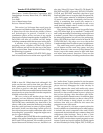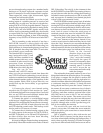
previously, and while they might bother some users, I
think that most people will be thrilled with what this
device can do. For one thing, it can be shoehorned into
a squashed-down rack space that many other upscale
players can only dream of achieving. Yes, it is
expensive by Best-Buy budget player standards, but
it is cheap compared to some other upscale units and
it can almost certainly play SACD and DVD-A releases
as well as any of them. Actually, it probably can do
this better than most, due to the admittedly not quite
comprehensive bass-management and distance-
compensation features.
The video performance was first-rate, and so was
the DD and DTS audio performance. I gave it a defect-
tracking test with the Canadian CD Check disc and it
tracked cleanly to defect check level 3, with substantial
interference (clicking) noises at levels 4 and 5.
Level-3 performance will handle just about any
kind of defect one might encounter with a CD,
although I have to admit that some of the other players
I have reviewed in the past could track level 4 cleanly.
(The earliest Yamaha player that I reviewed, the DVD-
S795, could do this, and the later DVD-S1200 had only
minor problems with level 4.) Given that players I have
fooled with that could only track level 1 cleanly still
sounded superb with musical source materials, any
hair splitting over greater defect tracking abilities is
just that: hair splitting.
Yep, the DVD-S1500 is a fine player, and I have
no problem recommending it to individuals who want
to play back SACD and DVD-A materials, in addition
to compact discs and DVD movie releases. Topping
things off, its musical performance with compact discs
is equal to that of any other players I have auditioned.
I pulled the cover off of the unit and gave the
digital to analog converter (DAC) number and some
other internal information to Dr. David Rich to
research. The model CS4382 DAC was built by Cirrus
Logic. These are the folks who now own Crystal
Semiconductor, a division of the company that does
data converter design work, and Dr. Rich checked the
Cirrus data sheet to come up with some info. He
indicated that the most important thing that separates
the great players from those that are merely good
involves the quality of the DAC. Below is some
technical info that is a review all by itself, courtesy of
Dr. Rich. You will not see technical summary like this
in our magazine very often, so pay attention.
-HF
Dr. David Rich on DACs, including the one
used in the DVD-S1500:
The CS4382 DAC delivers
better than average behavior. To make life easier for
our readers I am converting specification from the data
sheet into effective number of bits (ENOBS). From the
data sheet we find the CS4382 has typical 19-bit
performance for noise, and with worst case 18-bit
performance. When a manufacture states that a
parameter is “worst case,” this means that another
manufacturer using the part in his product can test
that part and expect it to meet the specification.
Unfortunately, a specification marked “typical” on
a specification sheet can be a problem, because many
manufacturers do not say what “typical” means.
However, any decent designer designs only with
worst-case numbers in mind if the parts performance
for what he is designing can affect the stated
specifications of the final system. For example, the
motor in a DVD player had better be able to spin fast
enough so the player can read the DVD. A “typical”
spin speed in the motor’s specification world not cut
it. In other words, the designer would want the motor
manufacturer to supply a worst-case motor spin speed
to make sure that the player can always meet minimum
standards.
With some DA converter specification listings,
only the “typical” specs are given. If the final-product
manufacturer uses those chips and has done no
assembly line testing to insure that DVD players
delivered to consumers meet some minimum
specification, many of those players may not do so.
This is the case, unless the manufacture indicates the
specification is guaranteed, as is the case under federal
law for amplifier power output under a specified load,
frequency range and THD. To my knowledge, the only
hi-fi company that currently states that the all the
specifications they issue are guaranteed minimums (or
maximums) is Accuphase.
The noise figures I have just given in ENOBS are










